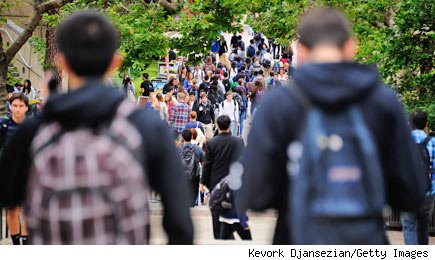 The rise in student loan debt is rapidly becoming one of the most troubling trends in the economy. When graduates emerge into a weak workforce deep in debt, they face huge pressure to find the highest-paying jobs they can find, yet they still often have to make huge sacrifices for years in order to dig their way out of the financial hole.With so many young adults struggling with loans, a recent call to maintain the current low 3.4% interest rate on new Stafford loans for another year sounds like a no-brainer. But former Education Secretary William Bennett thinks that low rates will only lead colleges to become more expensive.The scary side of low ratesBennett’s controversial position that the government should only subsidize student loan rates for poor households rather than the middle class raises a lot of debate. But buried underneath that provocative call was a more interesting observation: that low rates can actually boost tuition costs.
The rise in student loan debt is rapidly becoming one of the most troubling trends in the economy. When graduates emerge into a weak workforce deep in debt, they face huge pressure to find the highest-paying jobs they can find, yet they still often have to make huge sacrifices for years in order to dig their way out of the financial hole.With so many young adults struggling with loans, a recent call to maintain the current low 3.4% interest rate on new Stafford loans for another year sounds like a no-brainer. But former Education Secretary William Bennett thinks that low rates will only lead colleges to become more expensive.The scary side of low ratesBennett’s controversial position that the government should only subsidize student loan rates for poor households rather than the middle class raises a lot of debate. But buried underneath that provocative call was a more interesting observation: that low rates can actually boost tuition costs.
Bennett’s view has some evidence on its side from another part of the economy: real estate. During the early 2000s, low interest rates stoked red-hot demand for housing, making it possible for buyers of modest means to get favorable payment terms that made even expensive homes affordable — at least for a while. With a focus on creating the smallest monthly payments possible, innovations like interest-only mortgages led to many homeowners getting in way over their heads.Similarly, low interest rates make it possible for more students to afford college, giving universities every incentive to boost tuition in the face of that higher demand. As a result, even if monthly payments may end up lower, they’re charged on a higher baseline balance — which can end up costing students more in the long run.
Gallery: Private Colleges With the Lowest Student Graduating Debt
What’s far from clear, though, is whether higher rates would really force colleges to rein in tuition costs. Thus far, students have seemed more than willing to shoulder immense, unsustainable debt loads in order to get a college education. As outstanding student loans pass the $1 trillion mark, the question isn’t whether student debt will reach a breaking point — but rather when.
Related ArticlesForget Fountain Pens: 5 Gifts New College Grads Can Really UseChoosing a College: Which Schools Offer the Best ROI?5 Top Websites for Snaring College Financial AidPaying for College: Two Websites Offer Outside-of-the-Box Ideas
Motley Fool contributor Dan Caplinger is indebted to his parents for helping him avoid the student debt rat race. You can follow him on Twitter here.
